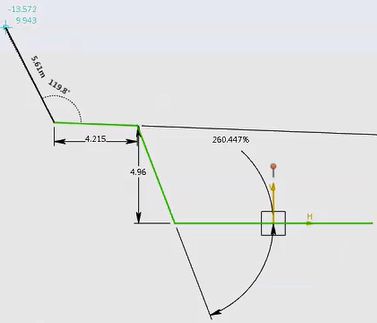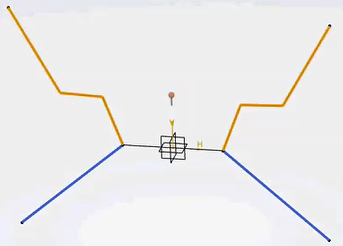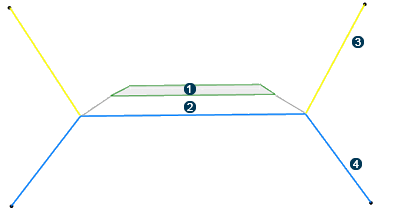Create a Sketcher-based Typical Cross Section
You can create a typical cross section that is an input necessary for earthwork design.
-
To create a sketcher-based typical cross section, from the Civil
Engineering section of the action bar, click Typical Cross
Section
 to
create a void typical cross section.
to
create a void typical cross section.

-
From the Typical Cross Section section of the action bar, click Excavation
Profile
 .
.
You must create two side profiles. It consists of two polylines, each corresponding to one side of the road/railway.
-
Draw the first side of the excavation profile in the
3D area
and double-click anywhere to validate.

In the Excavation Profile dialog box, you can see the status of the two sides of the profile before
 and
after
and
after  their creation .
their creation . -
Repeat the same step for the second side or click
 to generate the side 2 Profile symmetrical to the side 1
Profile automatically.
to generate the side 2 Profile symmetrical to the side 1
Profile automatically.
If side 2 Profile exists, it is replaced by the newly created symmetrical profile.
The Typical Cross Section node is created in tree. -
Click
OK to create a 3D output profile
corresponding to the excavation profile.
The excavation profile is created in the tree or the 3D area. It represents the geometry that will be removed from the ground. You can edit the profiles in the same way as for any sketch polyline.
Tip: After creating the profile, the status icon is green and the Create side 1 profile button changes into Edit side 1 profile in the Excavation Profile window. -
To add segments to the first created profile, click
Edit side 1 profile next to
 .
The cursor automatically moves at the end of the profile and you can add other segments to the existing profile. Repeat the same step on the second side of the profile if needed. To delete this side of the profile, click
.
The cursor automatically moves at the end of the profile and you can add other segments to the existing profile. Repeat the same step on the second side of the profile if needed. To delete this side of the profile, click .
.
-
From the Typical Cross Section section of the action bar, click Filling
Profile
 .
The filling profile is created in the tree or the 3D area. It represents the geometry that will be added on the ground. The creation of the filling profile is the same as for the excavation profile.
.
The filling profile is created in the tree or the 3D area. It represents the geometry that will be added on the ground. The creation of the filling profile is the same as for the excavation profile.
-
Click
Exit
 to go back to the
Civil Engineering 3D Design.
A typical cross section is created. The Filling profile is orange and the Excavation is blue:
to go back to the
Civil Engineering 3D Design.
A typical cross section is created. The Filling profile is orange and the Excavation is blue:
